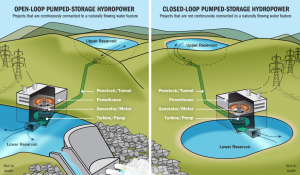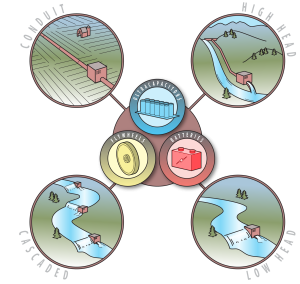INL Water Power
Program
Advancing water power research for a secure energy future
Hydropower is a wellspring for the future of secure power systems. Water power research and development at the Idaho National Laboratory is taking us there. Idaho National Laboratory’s water power team contributes to a variety of research areas ranging from irrigation technology to dam conversion. With water as the earth’s most abundant resource, research centered on water and its ability to provide power is essential to creating a reliable energy future.
INL News | Water Power
What is hydropower?

Hydropower, also known as hydroelectric power, is energy that comes from water. Hydropower is an economical form of electricity generation that harnesses the force of moving water. As water flows downhill, it serves as both an excellent power source and a natural battery to enable energy storage.
As water rushes through hydropower plants, it pushes the blades of turbines. Like propellers, these turbines spin when a force is applied to their blades. The force of the water spins the turbines, and generators in the plant translate the movement into electricity.
Innovations in hydropower increase the efficiency, resilience and capacity of water to power our industries and communities.
How does INL research support the future of hydropower?
 To advance next-generation hydropower and pumped storage systems for a flexible, reliable power grid, INL works with the U.S. Department of Energy’s Water Power Technologies Office to enable research, development and testing of emerging technologies.
To advance next-generation hydropower and pumped storage systems for a flexible, reliable power grid, INL works with the U.S. Department of Energy’s Water Power Technologies Office to enable research, development and testing of emerging technologies.
INL focuses on research to support hydropower and developing hydropower tools and technologies. INL researchers are innovating in:
Hybrid storage systems integration: INL designs power system controls to enable integration of hydropower with power storage technologies such as batteries and ultracapacitors. Storing energy from run-of-river hydropower creates a virtual reservoir that enables the combined system to contribute to grid stability and reliability, reduce wear on hydropower components, improve ramp times, and increase overall system efficiency.
Irrigation modernization: INL is leading a DOE effort to develop the “irrigation district of the future,” a concept that blends innovations from across the agriculture and energy domains to increase the benefits derived from irrigation systems.
Pumped storage hydropower simulation: To facilitate rapid prototyping of pumped storage hydropower design, INL develops models that enable unique, more representative environments to test controllers and power converter hardware.
What are the benefits of hydropower?
In 2023, hydropower plants produced roughly 6% of the United States electricity.
Hydropower provides an excellent way to produce base power levels for diverse energy systems. America’s industries and communities benefit from low and stable power costs, high system stability and the reliable nature of hydropower.
 Hydropower is affordable. Once infrastructure investments have been made, hydropower provides low, stable power costs to the consumer. Recent studies reveal that hydropower has the lowest levelized power cost across all major power sources. (Hydroreview.com, n.d.)
Hydropower is affordable. Once infrastructure investments have been made, hydropower provides low, stable power costs to the consumer. Recent studies reveal that hydropower has the lowest levelized power cost across all major power sources. (Hydroreview.com, n.d.)
Hydropower is a local and secure power source for the United States. The price of hydropower does not fluctuate according to foreign markets, and when we use hydropower, we are not dependent on foreign sources for power.
Hydropower is more consistent than most variable power sources. As a result, it is a common choice for ensuring that the minimal power need (called baseload) is met in communities that also use solar and wind energy. Hydropower’s ability to rapidly balance the energy load in a power system is one of its strongest advantages.
What are some types of hydropower generation?
Roughly two-thirds of hydropower generation comes from conventional dams. The remaining generation is from run-of-river projects, pumped storage hydropower plants, and tidal power stations. Emerging technologies in mini-hydropower systems and power storage are opening new opportunities for resilience through hydropower, hydropower in irrigation systems, and in concert with diverse energy technologies.

Conventional Hydropower Dams:
Conventional hydropower harnesses the power of water that is confined into a reservoir by a man-made dam. Once released, water flows from the reservoir to the river below. Along the way, it exerts a force that spins turbines, converting the energy to electricity via generators.
The most famous hydropower dam in the United States is the Hoover Dam, which powers a large swath of the Southwest United States. The enormous height difference between the upper reservoir (Lake Mead) and the outlet of water at the bottom of the dam contributes to the massive yearly 4.2 billion kilowatt-hours of energy it generates; enough to power over 385,000 homes for one year.
Pumped Storage Hydropower:
 In pumped storage hydropower systems, water is released from an upper reservoir to a lower reservoir when power is needed. On the way down, it runs through turbines and generates hydropower to supply the grid. When there is excess power in the grid, pumps can be activated to cycle the water back to the upper reservoir, where it is stored until the grid needs more electricity.
In pumped storage hydropower systems, water is released from an upper reservoir to a lower reservoir when power is needed. On the way down, it runs through turbines and generates hydropower to supply the grid. When there is excess power in the grid, pumps can be activated to cycle the water back to the upper reservoir, where it is stored until the grid needs more electricity.
Pumped storage systems can be coupled with intermittent power sources to store their power for later use. In these cases, when an intermittent source is active (e.g., the wind is blowing or the sun is shining) and generating more energy than the grid needs, it can be used to power the pumps that move water into the upper reservoir. When the grid needs more power than an intermittent source can provide, water is released from the upper reservoir to generate hydropower for the grid. Pumped storage systems help balance the energy supply to the load in a grid, improving the control and agility of power systems.
INL has an active research program developing computational models to support the design of pumped storage systems.
Run-of-river hydropower:
 Run-of-river (ROR) hydropower plants generate power from water as it is flowing downstream without a dam. These plants may take advantage of a natural drop in the river, or they may divert portions of the river. The water flows through turbines to generate electricity, and past the power plant to eventually rejoin the river. This technology has a wide array of applications from major river systems to small streams or canals. The amount of power generation varies widely according to source and machinery in the plant.
Run-of-river (ROR) hydropower plants generate power from water as it is flowing downstream without a dam. These plants may take advantage of a natural drop in the river, or they may divert portions of the river. The water flows through turbines to generate electricity, and past the power plant to eventually rejoin the river. This technology has a wide array of applications from major river systems to small streams or canals. The amount of power generation varies widely according to source and machinery in the plant.
INL has an active research program focused on integrating ROR hydropower with power storage solutions. This project involves a collaboration with a local utility, Idaho Falls Power, to test power storage options with ROR plants in Idaho Falls.
How does hydropower affect Idaho?
 According to DOE’s Energy Information Administration, Idaho typically generates more than three-fourths of its in-state electricity from alternative energy, primarily from hydroelectric sources. More than 140 existing hydroelectric plants throughout the state generated 60% of Idaho’s in-state electricity supply in 2018, which contributed to Idaho being among the 10 states with the lowest average electricity prices.
According to DOE’s Energy Information Administration, Idaho typically generates more than three-fourths of its in-state electricity from alternative energy, primarily from hydroelectric sources. More than 140 existing hydroelectric plants throughout the state generated 60% of Idaho’s in-state electricity supply in 2018, which contributed to Idaho being among the 10 states with the lowest average electricity prices.
The nation’s largest privately owned conventional hydroelectric generating facility is on the Idaho-Oregon border. The facility, owned by Idaho Power, is a three-dam complex on the Snake River in Hells Canyon, the deepest river gorge in North America.
